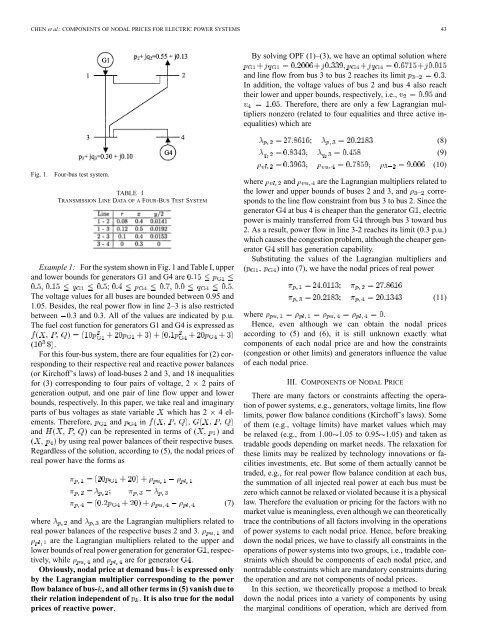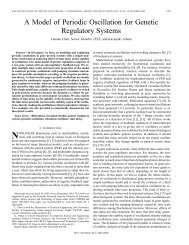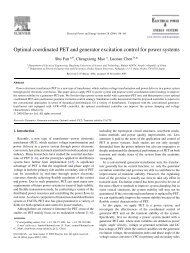Components of nodal prices for electric power systems - Power ...
Components of nodal prices for electric power systems - Power ...
Components of nodal prices for electric power systems - Power ...
You also want an ePaper? Increase the reach of your titles
YUMPU automatically turns print PDFs into web optimized ePapers that Google loves.
CHEN et al.: COMPONENTS OF NODAL PRICES FOR ELECTRIC POWER SYSTEMS 43By solving OPF (1)–(3), we have an optimal solution where,and line flow from bus 3 to bus 2 reaches its limit – .In addition, the voltage values <strong>of</strong> bus 2 and bus 4 also reachtheir lower and upper bounds, respectively, i.e., and. There<strong>for</strong>e, there are only a few Lagrangian multipliersnonzero (related to four equalities and three active inequalities)which areFig. 1.Four-bus test system.TABLE ITRANSMISSION LINE DATA OF A FOUR-BUS TEST SYSTEMExample 1: For the system shown in Fig. 1 and Table I, upperand lower bounds <strong>for</strong> generators G1 and G4 are, ; , .The voltage values <strong>for</strong> all buses are bounded between 0.95 and1.05. Besides, the real <strong>power</strong> flow in line 2–3 is also restrictedbetween 0.3 and 0.3. All <strong>of</strong> the values are indicated by p.u.The fuel cost function <strong>for</strong> generators G1 and G4 is expressed as.For this four-bus system, there are four equalities <strong>for</strong> (2) correspondingto their respective real and reactive <strong>power</strong> balances(or Kirch<strong>of</strong>f’s laws) <strong>of</strong> load-buses 2 and 3, and 18 inequalities<strong>for</strong> (3) corresponding to four pairs <strong>of</strong> voltage, 2 2 pairs <strong>of</strong>generation output, and one pair <strong>of</strong> line flow upper and lowerbounds, respectively. In this paper, we take real and imaginaryparts <strong>of</strong> bus voltages as state variable which has 2 4 elements.There<strong>for</strong>e, and in ,and can be represented in terms <strong>of</strong> andby using real <strong>power</strong> balances <strong>of</strong> their respective buses.Regardless <strong>of</strong> the solution, according to (5), the <strong>nodal</strong> <strong>prices</strong> <strong>of</strong>real <strong>power</strong> have the <strong>for</strong>ms aswhere and are the Lagrangian multipliers related toreal <strong>power</strong> balances <strong>of</strong> the respective buses 2 and 3. andare the Lagrangian multipliers related to the upper andlower bounds <strong>of</strong> real <strong>power</strong> generation <strong>for</strong> generator , respectively,while and are <strong>for</strong> generator .Obviously, <strong>nodal</strong> price at demand bus- is expressed onlyby the Lagrangian multiplier corresponding to the <strong>power</strong>flow balance <strong>of</strong> bus- , and all other terms in (5) vanish due totheir relation independent <strong>of</strong> . It is also true <strong>for</strong> the <strong>nodal</strong><strong>prices</strong> <strong>of</strong> reactive <strong>power</strong>.(7)(8)(9)(10)where and are the Lagrangian multipliers related tothe lower and upper bounds <strong>of</strong> buses 2 and 3, and – correspondsto the line flow constraint from bus 3 to bus 2. Since thegenerator at bus 4 is cheaper than the generator , <strong>electric</strong><strong>power</strong> is mainly transferred from through bus 3 toward bus2. As a result, <strong>power</strong> flow in line 3-2 reaches its limit (0.3 p.u.)which causes the congestion problem, although the cheaper generatorstill has generation capability.Substituting the values <strong>of</strong> the Lagrangian multipliers and( ) into (7), we have the <strong>nodal</strong> <strong>prices</strong> <strong>of</strong> real <strong>power</strong>(11)where .Hence, even although we can obtain the <strong>nodal</strong> <strong>prices</strong>according to (5) and (6), it is still unknown exactly whatcomponents <strong>of</strong> each <strong>nodal</strong> price are and how the constraints(congestion or other limits) and generators influence the value<strong>of</strong> each <strong>nodal</strong> price.III. COMPONENTS OF NODAL PRICEThere are many factors or constraints affecting the operation<strong>of</strong> <strong>power</strong> <strong>systems</strong>, e.g., generators, voltage limits, line flowlimits, <strong>power</strong> flow balance conditions (Kirch<strong>of</strong>f’s laws). Some<strong>of</strong> them (e.g., voltage limits) have market values which maybe relaxed (e.g., from 1.00 1.05 to 0.95 1.05) and taken astradable goods depending on market needs. The relaxation <strong>for</strong>these limits may be realized by technology innovations or facilitiesinvestments, etc. But some <strong>of</strong> them actually cannot betraded, e.g., <strong>for</strong> real <strong>power</strong> flow balance condition at each bus,the summation <strong>of</strong> all injected real <strong>power</strong> at each bus must bezero which cannot be relaxed or violated because it is a physicallaw. There<strong>for</strong>e the evaluation or pricing <strong>for</strong> the factors with nomarket value is meaningless, even although we can theoreticallytrace the contributions <strong>of</strong> all factors involving in the operations<strong>of</strong> <strong>power</strong> <strong>systems</strong> to each <strong>nodal</strong> price. Hence, be<strong>for</strong>e breakingdown the <strong>nodal</strong> <strong>prices</strong>, we have to classify all constraints in theoperations <strong>of</strong> <strong>power</strong> <strong>systems</strong> into two groups, i.e., tradable constraintswhich should be components <strong>of</strong> each <strong>nodal</strong> price, andnontradable constraints which are mandatory constraints duringthe operation and are not components <strong>of</strong> <strong>nodal</strong> <strong>prices</strong>.In this section, we theoretically propose a method to breakdown the <strong>nodal</strong> <strong>prices</strong> into a variety <strong>of</strong> components by usingthe marginal conditions <strong>of</strong> operation, which are derived from






